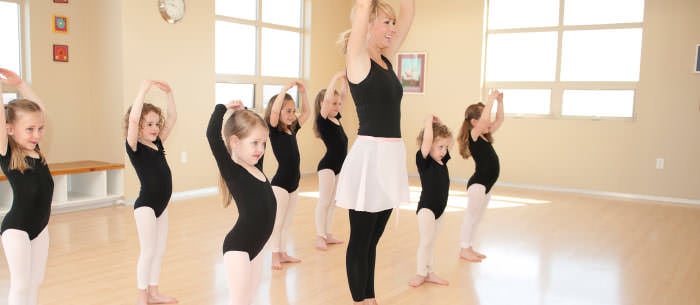Whether it’s tap, ballet, modern, jazz, hip-hop or African, dance classes remain popular all around the U.S. Though girls have traditionally been the participants in dance classes, boys are increasingly interested in the many aspects and benefits of dance. The cardiovascular and strength training benefits that go hand-in-hand with dance training (at various skill levels) make dance as much of a workout as any sport. Don’t overlook the potential of dance class to help your child grow, exercise, learn, and socialize.?Long gone are the days of pink tutus and classical music (though those are wonderful and you still have them if you want!).?Ethnic dance with exciting music, colorful costumes, and really local, neighborhood impact is burgeoning everywhere.
What Are The Benefits?
Television programs such as “So You Think You Can Dance” and “Dancing with the Stars” have done wonders to increase the popularity of and appreciation for dance. Besides creating a “cool factor,” dance provides children with physical benefits such as, general fitness, balance and coordination, discipline, and strength-training. Dance classes can be great for a child’s frame of mind too. It?is often used therapeutically to treat a wide variety of physical and mental health issues.
Dance Class Options
Here is a list of some of the more popular forms of dance and what to expect with each:
Ballet: This technical and beautiful form of dance has evolved with Italian, Russian and French influences. Expect your child (age 3 or older) to start ballet in a fun, recreational way. Keep in mind that ballet becomes more challenging and demanding as dancers improve. Ballet allows children to learn specific moves and encourages discipline in body and mind. Check with the dance school or teacher about how the instruction is given and what is expected of the students.
- Ballet classes vary widely in style and discipline. Classes run by professional ballet companies tend to be more formal and structured than those run by local community venues. They can also be quite a bit more expensive and require longer commitment.
- One advantage of taking ballet class run by a professional company is that the teacher and the teaching methods must meet the company’s standards for teaching technique and assessing skill level of students. Taking a class at a community venue or at your child’s school can be a great way to try ballet, without taking on a major commitment. But, both types of classes have their advantages and provide your child with exercise and fun.
Jazz: Children can begin taking jazz classes as early as age 5, but be aware that some of the moves can be complicated and kids may get frustrated if they can’t keep up. Jazz classes are taught by professional dance companies as well as through community venues and school.?In some cases, there are dance prerequisites students must have in order to take jazz lessons these will vary according to the dance school and level of jazz class. Don’t be frustrated by the prerequisites that might be in place for any given dance class they’re usually in place to protect your child from injury and to allow for a better teaching and learning experience in the class.
Tap: Born in America in the 19th century, tap dancing was named for the sound that tap dancers’ shoes make when the shoe’s metal plate claps the stage. Tap also has Scottish, Irish, and African influences. Kids can get involved with this exciting form of dance as early as 3 years old, but classes for young children should remain fun and improvisational. Like most forms of dance, tap becomes more rigorous and demanding as children grow and improve.
Latin: This genre encompasses dance styles like the cha-cha, rumba, salsa, and the mambo. Classes may be difficult for very young children, but kids aged 7 and up may be coordinated and motivated enough to take part in Latin dance. Check out Mad Hot Ballroom, a wonderful documentary about inner city kids from New York learning how to ballroom dance as part of their physical education classes.?They go on to compete in a regional dance contest.?Once you watch this you’ll be signing up for lessons yourself!?Latin dance is terrific exercise and the cultural appreciation of music and social interaction can have a positive influence kids.
African: African dance originates from a wide range of African social and religious traditions. Students studying this dance genre will be introduced to African songs, music and drumming during classes. Kids of any age may get involved as there are a variety of levels and types of African dancing to choose from.
Hip hop: Emerging in America in the 1970s, hip-hop dance celebrates urban music and encompasses movements, expressions and style from African-Americans and Latin-Americans. Any child or adult can get involved in hip-hop dance classes although particular moves (like break dancing) can be extremely challenging.
Recommendations and Safety Concerns
Like any sport, participation in a dance class involves some risk. You may want to peruse the National Dance Association or contact them for more information.?When enrolling your son or daughter in a dance class, you may also want to ask the program instructor or director the following questions:
- How long have you been teaching this type of dance?
- Do you have a certificate or diploma in teaching?
- Have all of your instructors had up-to-date background checks?
- What are the risks involved? Have any students been injured recently?
- What’s the best age for my child to start?
- Is this a co-ed class? What’s the ratio of boys to girls?
- Will my child have to practice at home or in the studio in addition to taking this class? Is there any extra cost involved (shoes, dancewear, costumes)?
- What awards or certificates are given out at the end of the program?
- What are the various class levels? If my child doesn’t progress to the next level, will he have to do this level over?
- Are parents allowed to watch the classes?
Lisa Tabachnick Hotta is a freelance writer and editor specializing in family issues. She lives with her family in Toronto, ON.






